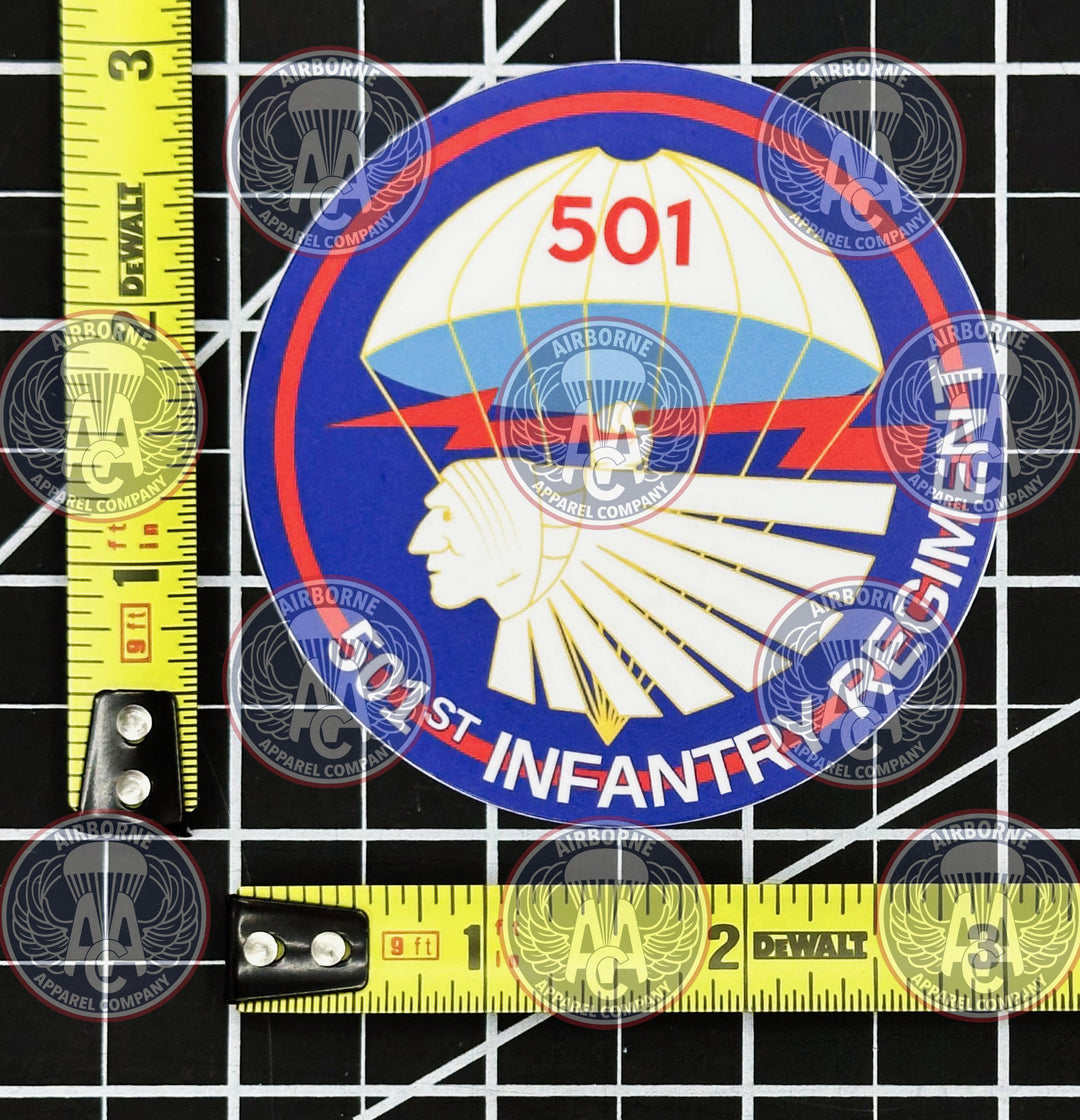The 501st Parachute Infantry Regiment (PIR), known as "Geronimo," is one of the most decorated and historically significant airborne units of the United States Army, with a lineage tracing its roots to the original parachute test platoon. Activated in 1942, the 501st PIR made a legendary name for itself during World War II as an integral part of the renowned 101st Airborne Division, the "Screaming Eagles," spearheading the D-Day invasion of Normandy and fighting pivotal battles in Operation Market Garden and the Battle of the Bulge at Bastogne, earning two Presidential Unit Citations. Today, the lineage of this highly decorated unit is proudly maintained by two active battalions: the 1st Battalion (1-501st IN), which is an Airborne unit assigned to the 2nd Infantry Brigade Combat Team (Airborne), 11th Airborne Division (the "Arctic Angels") stationed at Joint Base Elmendorf-Richardson, Alaska, and the 2nd Battalion (2-501st PIR), a paratrooper unit assigned to the 1st Brigade Combat Team, 82nd Airborne Division (the "All-Americans") at Fort Bragg, North Carolina.
The history of the 501st Parachute Infantry Regiment (PIR) is synonymous with the history of the U.S. Army's airborne forces. The unit's lineage is rooted in the original Parachute Test Platoon, formed on June 26, 1940, at Fort Benning, Georgia, providing the nucleus and heraldic background for what would become the 501st. The regiment itself was officially activated on November 15, 1942, at the famed Camp Toccoa, Georgia, under the command of Colonel Howard R. Johnson, whose leadership became legendary within the ranks.
World War II: "Geronimo" and the Tip of the Spear
Following rigorous training, the 501st PIR was permanently attached to the 101st Airborne Division in early 1944 as it prepared for the invasion of Europe. The regiment's first combat jump occurred during Operation Overlord on D-Day, June 6, 1944, into Normandy, France, hours before the beach landings. Tasked with securing the eastern flank of the invasion force and critical causeways, paratroopers of the 501st fought through scattered drop zones to achieve their objectives, earning the nickname "Geronimo" from the paratroopers who first shouted the word on a jump. For its gallantry during the Normandy Campaign, the 501st received a Presidential Distinguished Unit Citation.
Their next major action came in September 1944 as part of Operation Market Garden, the ambitious Allied attempt to seize key bridges in the Netherlands. The regiment jumped near the town of Veghel and secured critical bridges over the Aa River and Willems Canal, fighting tenaciously to keep the vital supply corridor, "Hell's Highway," open.
The 501st PIR cemented its heroic legacy during the Battle of the Bulge in December 1944. The regiment was rushed to the encircled town of Bastogne, Belgium, forming a critical part of the defense perimeter. Fighting in freezing conditions and facing massive German armor attacks, the 501st played a key role in repelling the assault and holding the line, contributing directly to the division's famous refusal to surrender. Their actions in Belgium earned them a second Presidential Distinguished Unit Citation. The unit finished the war participating in the final push into Germany before being deactivated at Fort Benning in August 1945.
Post-War and Vietnam
The regiment was reactivated and reorganized numerous times during the Cold War. In 1957, elements of the 501st were officially organized as the 2nd Airborne Battle Group, 501st Infantry, and assigned to the 82nd Airborne Division, adding the lineage to the "All-American" paratroopers.
By the Vietnam War, the regiment, redesignated as the 501st Airborne Infantry, was back with the 101st Airborne Division (Airmobile). The 2nd Battalion (2-501st) deployed in 1967 and participated in major campaigns including the Tet Offensive and subsequent counter-offensives. The unit was later involved in some of the war's most brutal fighting in the A Shau Valley and around Hue. It was during this conflict that Staff Sergeant Joe R. Hooper of the 2nd Battalion was awarded the Medal of Honor for conspicuous gallantry in action near Hue in 1968.
Global War on Terrorism and Modern Designations
The lineage of the 501st remained complex and dynamic in the post-Vietnam era, seeing reorganizations across multiple locations and divisions. In the 21st century, the regiment has played a critical role in the Global War on Terror.
-
The 1st Battalion, 501st Infantry Regiment (1-501st IN), maintained its full Airborne designation and was assigned to the 4th Brigade Combat Team (Airborne), 25th Infantry Division at Fort Richardson, Alaska. The battalion deployed multiple times to Operation Enduring Freedom in Afghanistan and later to Operation Iraqi Freedom in Iraq, continuing the unit's heritage of deploying as an immediate-response force into rugged and hostile territory.
-
The 2nd Battalion's lineage was again activated in 2013 as the 2nd Battalion, 501st Parachute Infantry Regiment (2-501st PIR) and assigned to the 1st Brigade Combat Team, 82nd Airborne Division at Fort Bragg (now Fort Liberty), North Carolina, where it serves as a rapid-deployment Paratrooper unit.
Current Status (Active)
The 501st Infantry Regiment remains an active, multi-component airborne unit, continuing its long tradition of service as a force-of-choice for rapid deployment.
-
1st Battalion, 501st Infantry Regiment (1-501st IN): This battalion is ACTIVE and is assigned to the 2nd Infantry Brigade Combat Team (Airborne), 11th Airborne Division (the "Arctic Angels"). It is stationed at Joint Base Elmendorf-Richardson, Alaska, where its troops are highly trained in both airborne operations and extreme cold weather tactics.
-
2nd Battalion, 501st Parachute Infantry Regiment (2-501st PIR): This battalion is ACTIVE and is assigned to the 1st Brigade Combat Team, 82nd Airborne Division. It is stationed at Fort Bragg, North Carolina, maintaining the combat readiness for global parachute assault missions characteristic of the 82nd Airborne.














